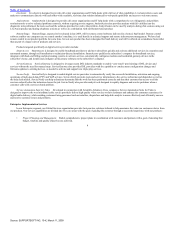Support.com 2008 Annual Report Download - page 21
Download and view the complete annual report
Please find page 21 of the 2008 Support.com annual report below. You can navigate through the pages in the report by either clicking on the pages listed below, or by using the keyword search tool below to find specific information within the annual report.
Table of Contents
outages and other technical difficulties, and it is vulnerable to damage or interruption from fires, floods, earthquakes, telecommunications and connectivity
failures, power failures, and similar events. This facility is also subject to risks from vandalism, break-ins, intrusion, and other malicious attacks. Despite
precautions taken, such as disaster recovery planning and back-up procedures, a natural disaster, act of terrorism or other unanticipated problem could cause a
loss of information and data and lengthy interruptions in the availability of our services and hosted software offerings because we do not operate or maintain fully
redundant systems. We rely on hosted systems maintained by third-party providers to deliver technical support services to consumers, including taking customer
orders, handling telecommunications for customer calls, and tracking sales and service delivery. Any interruption or failure of our internal or external systems
could prevent us or our service providers from accepting orders and delivering services, or cause company and customer data to be unintentionally disclosed. Our
continuing efforts to upgrade and enhance the security and reliability of our information technology and communications infrastructure could be very costly, and
we may have to expend significant resources to remedy problems such as a security breach or service interruption. Interruptions in our services resulting from
labor disputes, telephone or Internet failures, power or service outages, natural disasters or other events, or a security breach could reduce our revenue, increase
our costs, cause customers and channel partners to fail to renew or to terminate their use of our offerings, and harm our reputation and our ability to attract new
customers.
Because a small number of customers and channel partners have historically accounted for and may in future periods account for substantial portions
of our revenue, delays of specific programs or losses of certain customers could decrease our revenue.
A small number of customers and channel partners have historically accounted for, and may in future periods account for, substantial portions of our
revenue. For the fourth quarter of 2008, two companies, Customer A and Customer B accounted for 22% and 12% of total revenue, respectively. For the year
ended December 31, 2008, two companies, Customer A and Customer C accounted for 11% and 13% of our total revenue, respectively. In 2009, we are likely to
continue to derive a significant portion of our revenue from transactions with a limited number of customers and channel partners. Therefore, our revenue could
decline because of the loss of a single customer or delay of a significant program by a consumer partner. Additionally, we may not obtain new customers. The
failure to obtain significant new customers or alliances, the loss or delay of significant customer orders, the failure to establish and grow additional channel
partners and the failure to receive fees for products or services delivered would harm our operating results.
If existing customers in our Enterprise business do not renew maintenance contracts or purchase additional products and services, our operating
results could suffer.
Historically, we have derived, and expect to continue to derive, a significant portion of our total revenue from existing Enterprise customers who purchase
additional products and services and renew maintenance contracts. Our customers may not renew maintenance contracts, they may renew on less favorable terms
or at a reduced level of support, or they may not purchase additional products and services. Also, instability in the current macroeconomic climate may cause
certain customers to spend less on services or on maintenance renewals. In addition, as we introduce new products, our current customers may not require or
desire the functionality of our new products and may not ultimately purchase these products. Fewer new license customers or renewals in one period may lead to
a decrease in the amount of maintenance revenue in subsequent periods. If our customers do not renew maintenance contracts or do not purchase additional
products and services, our revenue would decline and our operating results would suffer.
Our sales cycle in our Enterprise business is lengthy and if revenue forecasted for a particular quarter is not realized in that quarter, significant
expenses incurred may not be offset by corresponding revenue.
Our sales cycle for our software in our Enterprise business typically ranges from three to nine months or more and may vary substantially from customer to
customer. The purchase of our products and services for
18
Source: SUPPORTSOFT INC, 10-K, March 11, 2009
























